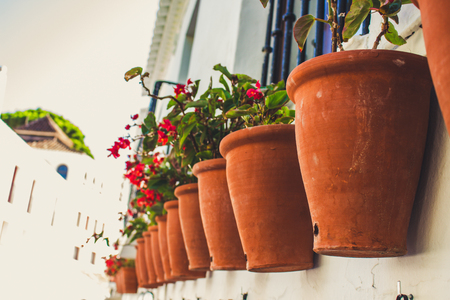1. Choosing the Right Containers
When it comes to container gardening in the summer, especially in urban or small spaces like balconies, patios, and rooftops, picking the right containers is key. The right choice can help manage soil temperature, retain moisture, and support healthy plant growth even in the heat.
Container Materials: What Works Best in Summer
Different materials affect how your plants handle summer conditions. Heres a quick comparison of common container types and how they perform in warm weather:
| Material | Pros | Cons |
|---|---|---|
| Plastic | Lightweight, affordable, retains moisture well | Can overheat in direct sun, may fade or crack over time |
| Ceramic (glazed) | Attractive, holds moisture better than unglazed clay | Heavy, can break easily if dropped |
| Terracotta (unglazed clay) | Porous for airflow, classic look | Dries out quickly, not ideal for hot climates without frequent watering |
| Fabric Grow Bags | Great drainage and root air pruning, lightweight and foldable | Might dry out faster; needs more frequent watering |
| Wooden Boxes/Planters | Natural insulation helps regulate temperature, customizable sizes | Can rot over time if not treated or lined properly |
Size Matters: Give Roots Room to Breathe
The size of your container plays a big role in plant health during summer. Larger containers hold more soil, which means better moisture retention and less temperature fluctuation. This is especially helpful when temperatures soar.
Tips for Choosing the Right Size:
- Herbs: Use containers at least 6–8 inches deep.
- Lettuce and leafy greens: 6–10 inches deep works well.
- Tomatoes and peppers: Aim for containers that are at least 12–18 inches deep and wide.
- Dwarf fruit trees or larger vegetables: Choose large pots—20 inches or more in diameter.
Drainage Is Non-Negotiable
No matter what type of container you choose, make sure it has proper drainage holes. Without drainage, excess water builds up and causes root rot—a fast way to lose plants during summer heatwaves. If youre using decorative containers without holes, place a smaller pot with holes inside them or drill holes yourself if possible.
Lightweight Options for Urban Living
If youre gardening on a balcony or rooftop where weight matters, go for plastic, fabric grow bags, or lightweight composite containers. These options are easier to move around as the sun shifts throughout the day and are safer for elevated structures.
Pro Tip:
Add rolling plant caddies underneath heavy containers so you can easily reposition them based on sunlight or shelter needs during extreme heat.
Selecting the right containers sets the foundation for a successful summer garden—even in tight urban spaces. With smart material choices and proper sizing, your plants will stay cooler, healthier, and more productive all season long.
2. Selecting Heat-Tolerant Plants
When gardening in urban settings during the summer, its essential to choose plants that can handle high temperatures and thrive in limited space. Whether youre working with a small balcony, rooftop, or patio, selecting the right heat-tolerant vegetables, herbs, and ornamental plants will help your container garden flourish all season long.
Vegetables That Love the Heat
Some vegetables are naturally suited for hot weather and compact growing conditions. Here are a few top choices:
| Vegetable | Why Its Great for Summer Containers |
|---|---|
| Tomatoes (especially cherry varieties) | Compact options like Tiny Tim thrive in pots and love full sun. |
| Peppers (bell and hot types) | Heat-loving and do well in containers with plenty of sunlight. |
| Eggplant | Dwarf varieties like Patio Baby are perfect for small spaces. |
| Zucchini | Choose bush varieties like Raven that don’t sprawl too much. |
Herbs That Thrive in Summer Heat
Many herbs not only tolerate but actually prefer warm temperatures. Theyre also great for pots and window boxes:
- Basil: Loves heat and grows quickly; ideal for sunny balconies.
- Rosemary: Drought-tolerant once established; needs a deep pot with good drainage.
- Oregano: Hardy and thrives in hot, dry conditions; perfect for small planters.
- Thyme: Low-maintenance and fragrant; does well even in shallow containers.
Ornamental Plants for Color and Texture
If you want to add beauty alongside your edibles, there are plenty of ornamental plants that enjoy summer heat and city living:
| Plant | Container Garden Benefits |
|---|---|
| Lantana | Tolerates extreme heat and adds bright blooms all summer long. |
| Pentas | Attracts pollinators and thrives in direct sun. |
| Coleus (sun-tolerant varieties) | Adds vibrant foliage color to shady corners or partial sun spots. |
| Portulaca (Moss Rose) | Drought-resistant with colorful blooms; great for shallow containers. |
Pro Tips for Urban Container Gardening
- Select lightweight pots to reduce strain on balconies or rooftops.
- Use high-quality potting mix designed for containers to retain moisture without waterlogging roots.
- Avoid overcrowding – give each plant enough room to grow and breathe.
The right plant choices make all the difference when gardening in tight urban spaces under the summer sun. Stick with these heat-loving favorites to keep your container garden vibrant, productive, and easy to manage throughout the hottest months.

3. Soil, Watering, and Fertilization
When it comes to container gardening in the summer—especially in urban settings or small spaces like balconies or patios—getting your soil, watering, and fertilization right is key to growing healthy, productive plants.
Choose the Right Potting Mix
A high-quality potting mix is essential for container gardens. Avoid using garden soil; its too heavy and can lead to poor drainage and root rot. Instead, look for a commercial potting mix labeled for containers. These mixes are lightweight, well-draining, and often contain added nutrients to help your plants thrive.
What to Look for in a Good Potting Mix:
| Ingredient | Purpose |
|---|---|
| Peat moss or coconut coir | Helps retain moisture |
| Perlite or vermiculite | Improves drainage and aeration |
| Compost or slow-release fertilizer | Provides nutrients over time |
Watering Techniques for Hot Weather
During the summer, container plants dry out quickly due to heat and wind exposure. Regular watering is crucial—but so is doing it correctly.
Summer Watering Tips:
- Check daily: Stick your finger about an inch into the soil. If it feels dry, it’s time to water.
- Water deeply: Make sure water runs out of the drainage holes. This ensures roots are getting hydrated.
- Morning is best: Watering early helps reduce evaporation and gives plants a good start to handle the heat.
- Avoid wet foliage: Try not to get leaves wet to prevent fungal issues, especially in humid climates.
Fertilizing Your Container Garden
Potted plants rely on you for nutrients since they cant draw from garden soil. A regular fertilization schedule keeps them strong through the growing season.
Recommended Fertilization Schedule:
| Type of Plant | Fertilizer Type | Frequency |
|---|---|---|
| Leafy greens (lettuce, spinach) | Nitrogen-rich liquid fertilizer | Every 1–2 weeks |
| Flowering plants (petunias, geraniums) | Balanced liquid fertilizer (10-10-10) | Every 2 weeks |
| Fruit/vegetable plants (tomatoes, peppers) | Tomato or vegetable-specific fertilizer | Every 1–2 weeks once fruiting starts |
If youre using a slow-release fertilizer mixed into your potting soil, you can supplement with occasional liquid feedings during peak growth periods. Always follow package instructions to avoid over-fertilizing, which can damage roots and stunt growth.
Caring for your container garden during the hot summer months takes a little extra attention—but with the right soil, smart watering habits, and consistent feeding, your urban oasis can stay lush and productive all season long.
4. Maximizing Small Spaces
Urban gardening often means working with limited space, but that doesn’t mean you can’t grow a thriving summer garden. With a little creativity, balconies, patios, and rooftops can be transformed into lush, productive spaces using vertical gardening, hanging planters, and smart layouts.
Vertical Gardening Ideas
Vertical gardening is one of the best ways to make the most of small areas. It allows you to grow upward instead of outward, saving precious floor space. Here are a few popular methods:
| Method | Description | Best For |
|---|---|---|
| Wall Planters | Mounted on fences or walls, these hold multiple plants in pockets or containers. | Herbs, lettuce, strawberries |
| Trellises & Obelisks | Support climbing plants like beans or tomatoes. | Cucumbers, peas, pole beans |
| Shelves & Ladder Stands | Tiered plant stands that allow different plants to share sunlight. | Potted flowers, succulents, herbs |
| Pallet Gardens | Upcycled wooden pallets turned into vertical growing beds. | Leafy greens, small root vegetables |
Hanging Planter Solutions
Hanging planters are perfect for freeing up ground space while adding visual interest at eye level or above. They’re great for:
- Trailing plants: Like ivy or sweet potato vines that spill over beautifully.
- Compact edibles: Such as cherry tomatoes or strawberries.
- Herb clusters: Hang several small pots together for easy kitchen access.
You can hang planters from balcony railings, pergolas, or even install ceiling hooks on covered patios. Just ensure they have proper drainage and are secure against strong summer winds.
Clever Layouts for Tight Areas
A well-thought-out layout makes all the difference in a small garden. Consider these tips when planning your container setup:
| Layout Strategy | Benefits |
|---|---|
| Group by Sunlight Needs | Makes watering and care easier; reduces plant stress. |
| Create Walking Paths | Avoid crowding; keeps the area functional and safe. |
| Use Stackable Containers | Add height without taking up more floor space. |
| Rotate Seasonal Crops | Keeps garden productive throughout summer months. |
No matter how compact your outdoor space may be, with smart design and the right tools, your container garden can flourish all summer long.
5. Pest and Sun Protection
Summer in the city can be tough on container gardens. Between intense sunlight, sudden gusts of wind, and pests like aphids or spider mites, your plants need a little extra care to thrive. Here are some simple ways to protect your urban garden during the hottest months.
Shielding Plants from Intense Sunlight
Too much direct sun can scorch leaves, especially for tender herbs and leafy greens. Use these strategies to keep them safe:
- Move containers: Place pots where they get morning sun and afternoon shade—east-facing balconies or patios are ideal.
- Use shade cloth: A lightweight fabric stretched above or around plants can reduce sun intensity while still allowing airflow.
- Select heat-tolerant varieties: Choose plants that naturally handle high heat like cherry tomatoes, peppers, or succulents.
Protecting Against Wind Damage
Urban rooftops and balconies often deal with strong winds that can dry out soil or topple plants. Try these tips:
- Group containers together: This creates a microclimate and provides mutual support against wind.
- Add support stakes: For tall or vining plants, secure them with bamboo stakes or trellises.
- Use heavier pots: Terra cotta or ceramic planters are more stable than lightweight plastic ones.
Common Urban Garden Pests and How to Manage Them
Pests love warm weather as much as your plants do. Keep an eye out for these common intruders and use the following methods to manage them naturally:
| Pest | Description | Control Tips |
|---|---|---|
| Aphids | Tiny green or black insects that cluster on new growth | Spray with a mix of water and a few drops of dish soap; introduce ladybugs if possible |
| Spider Mites | Tiny red dots under leaves; cause webbing and leaf discoloration | Mist plants regularly to increase humidity; use neem oil spray weekly |
| Caterpillars | Chew holes in leaves; often hide under foliage | Hand-pick in the early morning; try BT (Bacillus thuringiensis) if infestation is heavy |
Avoiding Chemical Pesticides
If you’re growing edible plants, its best to avoid harsh chemicals. Stick with natural pest control methods like neem oil, insecticidal soap, or companion planting (e.g., marigolds to deter aphids).
A Quick Tip:
Add mulch to your containers! It helps regulate soil temperature, conserves moisture, and can even deter some pests.


